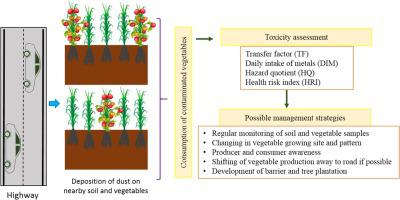Environmental Toxicology and Pharmacology ( IF 4.2 ) Pub Date : 2020-12-10 , DOI: 10.1016/j.etap.2020.103563 Neha Gupta , Krishna Kumar Yadav , Vinit Kumar , Santhana Krishnan , Sandeep Kumar , Zahra Derakhshan Nejad , M.A. Majeed Khan , Javed Alam

|
This study determined the heavy metals (HMs) accumulation in different vegetables in different seasons and attributed a serious health hazard to human adults due to the consumption of such vegetables in Jhansi. The total amounts of zinc (Zn), lead (Pb), nickel (Ni), manganese (Mn), copper (Cu), cobalt (Co), and cadmium (Cd) were analysed in 28 composite samples of soil and vegetables (Fenugreek, spinach, eggplant, and chilli) collected from seven agricultural fields. The transfer factor (TF) of HMs from soil to analysed vegetables was calculated, and significant non-carcinogenic health risks due to exposure to analysed heavy metals via consumption of these vegetables were computed. The statistical analysis involving Principal Component Analysis (PCA) and Pearson's correlation matrix suggested that anthropogenic activities were a major source of HMs in the study areas. The target hazard quotient of Cd, Mn, and Pb for fenugreek (2.156, 2.143, and 2.228, respectively) and spinach (3.697, 3.509, 5.539, respectively) exceeded the unity, indicating the high possibilities of non-carcinogenic health risks if regularly consumed by human beings. This study strongly suggests the continuous monitoring of soil, irrigation water, and vegetables to prohibit excessive accumulation in the food chain.
中文翻译:

评价印度北部地区土壤和蔬菜中的重金属污染:水平,迁移和潜在的人类健康风险分析
这项研究确定了不同季节不同蔬菜中重金属(HMs)的积累,并归因于詹西(Jhansi)食用此类蔬菜而对成年人造成严重的健康危害。分析了28种土壤和蔬菜的复合样品中锌(Zn),铅(Pb),镍(Ni),锰(Mn),铜(Cu),钴(Co)和镉(Cd)的总量(胡芦巴,菠菜,茄子和辣椒)来自七个农业领域。计算了土壤中HMs从土壤到被分析蔬菜的转移因子(TF),并计算了由于食用这些蔬菜而暴露于被分析重金属引起的重大非致癌健康风险。涉及主成分分析(PCA)和Pearson's的统计分析 相关矩阵表明,人为活动是研究区域HMs的主要来源。胡芦巴(分别为2.156、2.143和2.228)和菠菜(分别为3.697、3.509、5.539)的Cd,Mn和Pb的目标危险系数超过了1,表明如果定期进行,则非致癌健康风险的可能性很高被人类消耗。这项研究强烈建议对土壤,灌溉水和蔬菜进行连续监测,以防止食物链中过多积累。











































 京公网安备 11010802027423号
京公网安备 11010802027423号